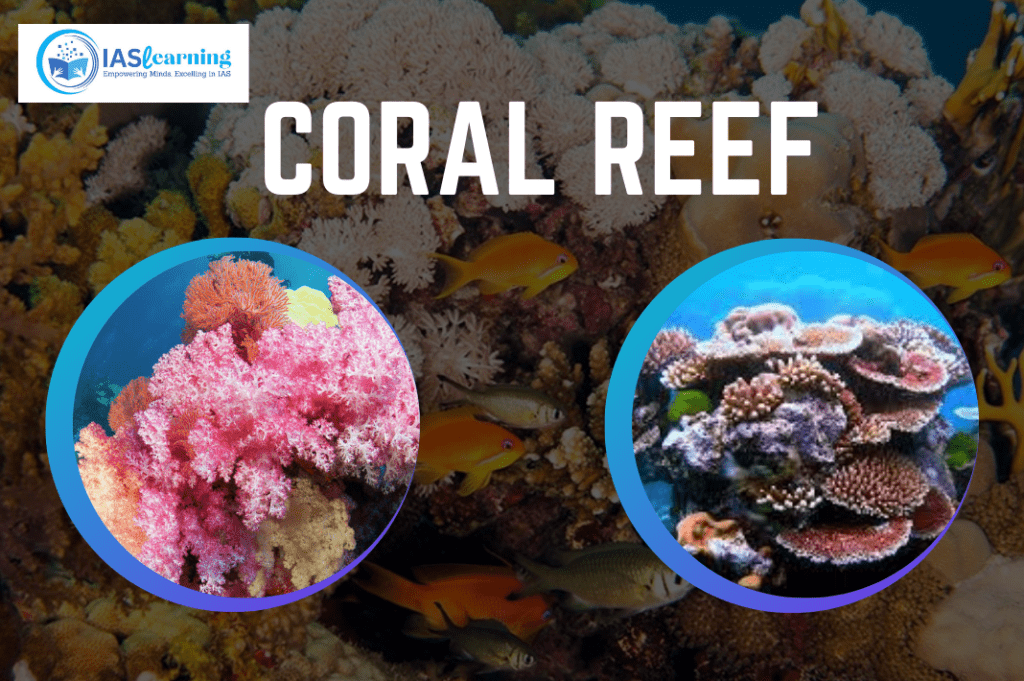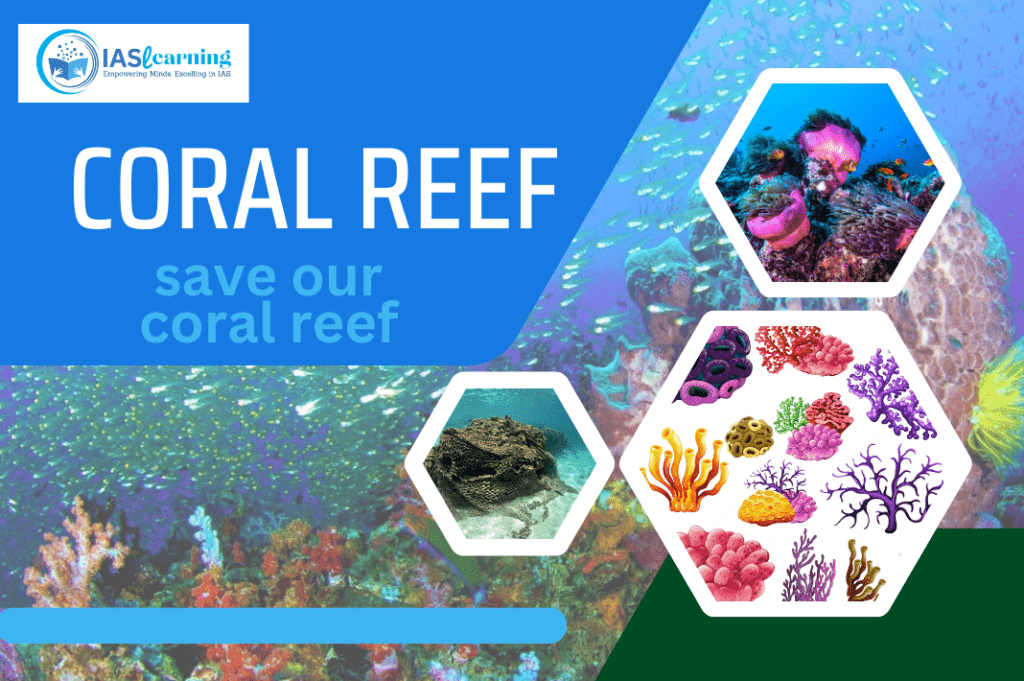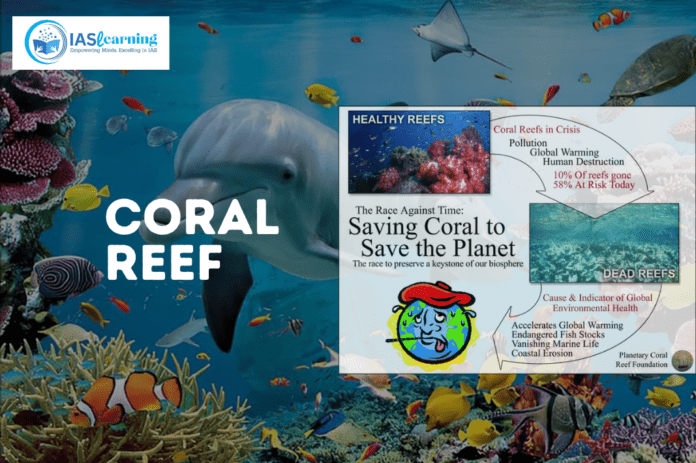About Coral Reef
- Millions of little, fleshy polyps that form vast carbonate structures to form coral reefs. Corals can be found worldwide in both shallow and deep water, however reef-building corals are only present in these habitats in shallow tropical and subtropical waters.
- Deep-sea corals thrive in 6,000 meters of cold, gloomy water. Although they develop slowly, deep-sea corals don’t have the same algae and don’t need sunlight or warm water to survive.
Process of coral reef formation
- Coral polyps typically coexist with the microscopic algae known as Zooxanthellae in shallow waters, where they have a mutually beneficial relationship. Because of its capacity for photosynthesis, this algae provides the coral polyps with the carbon molecules they need to produce energy. In exchange, the polyps offer Zooxanthellae defense.
- When coral larvae that are capable of movement cling to sedimentary rocks or other solid surfaces close to coasts, coral reefs are created. This process is carried out with the aid of a number of additional processes, including coral polyp skeleton solidification, cementation, compaction, sedimentation, and solidification.

Types of Coral reef
- Coral reefs are broadly categorized based on large-scale reef morphology, which includes a reef’s size, shape, and, if any, proximity to nearby land.
- Within a given biogeographic region, there is frequently a large lot of overlap between the major reef types in terms of the dominating animal and plant species as well as their ecological interactions.
Coral reefs come in three main varieties: atoll, barrier, and fringing reef.
Coastal Reef: Of the three main forms of coral reefs, it is by far the most prevalent. It is an island or coral platform connected to a continental coast that is occasionally divided from it by a small, shallow lagoon or channel.
Fence Reef :The longest and widest of the three reefs, it stretches for hundreds of kilometers. It wraps like a crooked, asymmetrical ring approximately parallel to the coast or an island.
A barrier reef is distinguished by its distance from the shore and the presence of a wider and deeper lagoon. The lagoon may occasionally be connected to the ocean by one or more canals that traverse the barrier reef.
Atolls
- It is a reef that resembles a ring that partially or entirely encloses a lagoon. Although the lagoon’s surface may be level, the reef’s seaward side drops sharply into the deep ocean.
- Through a variety of channels that penetrate the reef, the lagoon’s depth ranges from 80 to 150 meters, and it can be connected to the ocean.
- Atolls are far from deep-sea platforms, where underwater features like a buried island or a volcanic cone that may rise to a level suited for coral growth may aid in the construction of atolls.
- In comparison to other oceans, the Pacific has by far the most atolls. Atolls like the Funafuti atoll in Ellice Island and the Fiji atoll are well-known examples.The Lakshadweep islands also have a significant number of atolls.
- Atoll structures can be found in great numbers in the Indian Ocean. Examples can be found in the Cocos Island group, the Seychelles, the Maldives, and the Chagos island groupings.

The ideal environment for the growth of corals
- For coral reefs to develop to their maximum potential, some requirements must be met.
- Coral reefs must develop in shallow water in order to flourish. The distance between the reef’s surface and the water’s surface should not exceed 80 meters. The photosynthetic activities carried out by the Zooxanthellae require sufficient sunshine.
- Surface Prerequisite: The coral polyp skeletons must be compacted, cemented, and solidified on a semi-hard or hard surface.
- Clear Water: In locations with waters that are contaminated with sediment, the lovely coral polyps die. Additionally, they vanish from seas that are murky. This is due to the fact that the presence of sediments and murky water restricts the amount of sunlight that can reach the algae that support their existence.
- Coral reefs are inextricably linked to the warm ocean waters. The water must be close to 20 degrees in temperature. So, coral reefs typically predominate on a continent’s eastern shore. This is not the situation with India, either, as the eastern seas are heavily contaminated with sediment.
- Saline-filled Waters: Coral polyp development is greatly aided by the little saltiness of ocean waters. For the purpose of preserving their skeletons, the polyps draw calcium from the water. Therefore, for coral reefs to thrive, there must be a low salinity environment.
- Rich Supply of Nutrients: Coral reefs thrive in ocean waters due to the steady flow of rich nutrients supported by ocean waves. Coral polyps multiply more quickly when given nourishment.
geographic range of coral reef
- Tropical and subtropical waters are home to most reef-building corals. These typically occur between the latitudes of 30° north and 30° south.
- The largest number of reefs and the widest variety of coral are found in the Indonesian/Philippine archipelago.
- The Caribbean, which has significantly less diversity than any major Indo-Pacific regions, the Red Sea, and Australia’s Great Barrier Reef are other regions with a concentration of reefs.
- The Caribbean/Western Atlantic, Eastern Pacific, Central and Western Pacific, Indian Ocean, Arabian Gulf, and Red Sea are the world’s primary coral reef regions.
Indian coral reefs
- India is said to have a coastline of about 7,517 kilometres, although only 6,100 km of that coastline is on the continent. Fringing, barrier, and atoll coral reefs are the three main varieties found in India.
- There are many places in India where coral reefs can be found, such as the Gulf of Kutch, Gulf of Mannar, Palk Bay, Andaman & Nicobar, and Lakshadweep Islands. Some of the world’s most northerly reefs are in the northwest’s Gulf of Kutch.
- Coral reef patches can also be found at the Gaveshani Bank, west of Mangalore, and in Ratnagiri, Malvan, and Redi, south Bombay.
Corals are important to both marine life and humans.
For the following reasons, corals are crucial to marine life:
- Coral Diversity: A wide variety of marine creatures depend on coral reefs for nutrition, protection, reproductive success, and medical care. Strong marine life is supported by healthy corals, but sick corals can cause the loss of marine life, upsetting the food chain. Corals are essential to the marine ecosystem’s health. They are referred to as the ocean’s rainforests since they are home to a variety of habitats. As the sea’s pharmacy, coral reefs are believed to be.
- Fishing: A wide range of fish can survive on coral reefs. Corals are important to fishing communities because they help fish species migrate seasonally. Fishing activity may decrease due to unhealthy corals, harming the economy. Certain fishing companies only use coral reefs.
- Coral reefs serve as a barrier, shielding the coastline from powerful ocean currents, storms, and waves. These natural barriers have taken on an excessive amount of significance as a result of the rise in cyclone frequency in India caused by climate change.
- Indian monsoon insights: According to a recent study by the Indian Institute of Meteorology, corals along the northwestern coast provide information on the patterns of the arrival and departure of the Indian monsoon.
- Marine Tourism: Because of these stunning corals, the majority of the gross national product of nations with coral reef industries comes from the tourism industry. According to a research, coral reefs are worth $10 billion, and they provide about $360 million in direct economic benefits annually.
Threats to Coral reef
Numerous dangers to coral reefs are caused directly or indirectly by human activity. By 2050, all coral reefs are expected to be threatened, with 75% of those hazards being of high risk. Some of these dangers include:
- Global Warming: The oceans are becoming more acidic as a result of global warming, endangering the coral environment. Additionally, as glaciers throughout the planet melt, sea levels are rising. Because of inadequate sunshine and drowning caused by rising sea levels, coral reefs grow slowly.
- Coral Bleaching: When the waters get warmer, coral bleaching occurs. Corals become stressed and release a symbiotic algae as a result because they have a limited temperature tolerance. They lose their source of life when the algae is gone, which results in their extinction.
- Warm sea temperatures, very low tides, ocean acidification, ocean pollution, illnesses, sedimentation, anthropogenic threats, and predators are a few of the factors that contribute to coral bleaching.
- Marine Pollution: Corals are dying as a result of plastic pollution and other forms of marine pollution. To breathe, coral reefs require both air and space. We might lose them sooner than we anticipated due to the increasing levels of sea pollution.
- Ocean acidification and Stronger Storms: The increase in storm intensity has resulted in oceanic waves that break and harm coral reefs. They may even destroy colonies and make them dangerous places to live. The pH levels rise as more and more CO2 is absorbed by the water. Coral skeletons weakened by high pH levels are more susceptible to disease and storm damage.
- Coral polyps have built-in UV protection against ozone depletion. However, if radiation levels rise, corals in shallow waters are in risk of being harmed or perhaps destroyed.

Recent Coral Reef-Related Developments
- Large areas of Thailand’s sea floor are being devastated by the “yellow band disease,” a condition that is fast spreading. According to scientists, the reefs may be more vulnerable to yellow-band disease as a result of overfishing, pollution, and rising ocean temperatures brought on by climate change.
- For the preceding 36 years, the Great Barrier Reef (GBR) in northern and central Australia has had a high coral reef cover. Reef ecosystems are adaptable and may bounce back from disturbances like predator assaults, cyclones, and heat stress. However, the researchers issued a warning that the benefits might soon be undone as a result of rising global temperatures. The primary danger to the reef’s health is heat stress brought on by climate change, which causes coral bleaching.
Strategies for conserving coral reefs
- Enhancing Coral Habitat Quality: This entails providing funding for research and the creation of strategies to lessen invasive and obtrusive species that compete with corals for habitat.
- Keeping Corals and Their Habitat from Being Lost: The decrease of coral reef deterioration is facilitated by identifying high-risk areas, assisting with emergency response, and recovering damages from natural occurrences such vessel groundings.
- Improved coral larvae resilience and lower mortality rates will be achieved through the research and development of novel techniques. Additionally, we are establishing partnerships to support restoration on ecologically relevant scales.
- Improved coral disease management techniques and a decrease in the impact of organisms that prey on corals would help increase coral survival rates at important reef regions.
Global Programs to Protect Coral Reefs
Around the world, there are numerous regional and international projects devoted to various facets of coral reef study, information exchange, protection, and management. These programs aid nations in their endeavors to meet the Sustainable Development Goals and the Aichi Biodiversity Targets.
- The International Coral Reef Initiative’s (ICRI’s) operational Global Coral Reef Monitoring Network (GCRMN) has as its main responsibility reporting on the state of coral reefs throughout the world.
- Initiative for a sustainable ocean
- UN Environment collaboration for the world’s coral reefs
- international project for coral reefs
- Network for observing ocean acidification globally (GOA-ON)
- Ramsar Conference
- Coral Triangle Project
Coral reef protection measures in India
- The Schedule-I list of the Wildlife Protection Act of 1972 includes corals.By notification dated July 11, 2001, the Ministry of Environment and Forest included all hard coral to the WLPA of 1972’s Schedule List.
- The Environment Protection Act of 1986 (EPA) gives the Central Government sole authority to safeguard and conserve the maritime environment as well as to stop and manage marine pollution.
- The only regulation that expressly forbids coral mining in India is the Coastal Regulation Zone Notification (CRZ), 1991, under the EPA.
- Marine Protected Areas (MPAs): to protect specific portions of the country’s oceans, including several coral reef-containing regions.
Conclusion
Life has existed on coral reefs for over a million years. Marine life thrives there thanks to its rich habitat. Interfering with the coral reefs is not in our best interests. Therefore, conservation measures should be adopted to safeguard these lovely polyps. Laws should be scrupulously upheld, and if they are violated, prompt consequences should be applied. Preventing the erosion and deterioration of our corals is in our best interests. Let’s agree to do everything in our power to keep them safe today.
Read morehttps://coral.org/en/
For further detailshttps://iaslearning.in/




